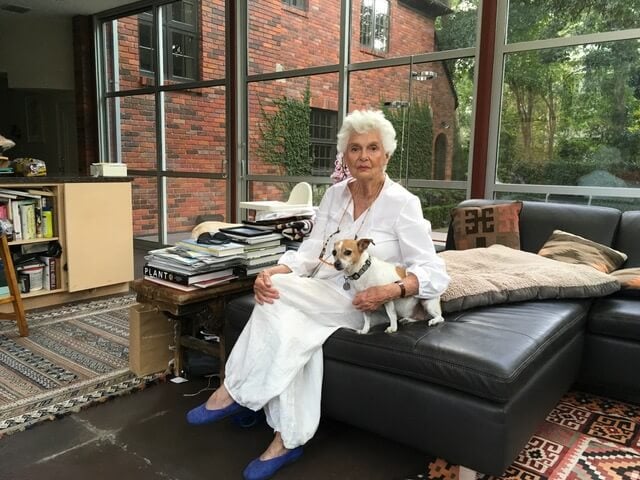Simone Withers Swan, who introduced Nubian vaulted adobe construction to the Chihuahuan desert of Texas and Mexico at the turn of the 21st century, died in Tucson, Arizona, on January 16, 2025. She was 96 years old.
 Simone Swan was a legendary personality: mercurial, seductive, cultivated, curious, determined, imperious. She was by turns an architectural patron, architectural muse, construction foreman, and construction teacher.
Simone Swan was a legendary personality: mercurial, seductive, cultivated, curious, determined, imperious. She was by turns an architectural patron, architectural muse, construction foreman, and construction teacher.
During the 1970s, architecture editor Peter Blake prevailed on her to write for his magazine, Architecture Plus, about contemporary architecture in Africa.
In 1975, Swan made the acquaintance of the Cairo architect Hassan Fathy. Between 1975 and 1980, she traveled to Cairo numerous times to help Fathy put his papers in order and to learn the basics of Nubian adobe construction. This was a traditional practice that Fathy became aware of in the 1940s, and which he subsequently promoted as a sustainable, socially responsible technology that enabled low-income people in arid climates to construct their own dwellings. What is singular about Nubian adobe construction is that it employs adobe domes and catenary adobe vaults to enclose buildings. No other materials are required, not even wood formwork.
When, in 1991, Swan first visited the Trans-Pecos region of Texas, the far western tip of the state where El Paso and Marfa are located, she recognized parallels between its arid climate and desert landscape and those of Egypt. Adobe was already the most venerable building technology in the Trans-Pecos (and in the neighboring state of New Mexico and, across the Río Grande, in the Mexican state of Chihuahua). In 1995, Swan acquired property outside the border town of Presidio, Texas, where she determined to build vaulted adobe structures.
In 1998 Swan began construction of Casa Swan, a 1,600-square-foot, off-grid, desert house with adobe vaults and domes. With the aid of her colleagues from Ojinaga, she started an adobe construction workshop, teaching all phases of the manufacturing and construction process. Swan attracted an international array of students (including architect Ronald Rael) for what became the annual November workshop of the Adobe Alliance, the nonprofit she had started in 1993.
To document Swan’s work and that of the Adobe Alliance, Dennis Dollens wrote Simone Swan: Adobe Building, published by SITES in 2005. In 2016, she received an Honorary Lifetime Membership from The Earthbuilders’ Guild.
Swan’s friend, Houston artist and patron Surpik Angelini, wrote of her: “Simone was a soul whisperer to celebrated and upcoming artists, architects, anthropologists, philosophers, writers, filmmakers, musical composers, ecologists, freedom fighters, activists, and humble adobe builders, all geniuses in their own fields who changed our world for good. On a personal level, Simone was an unadulterated child, marveling at everything that brought new knowledge, and an old sage with an unerring wisdom rooted in many past lives in magnificent ancestral cultures.”
In a remembrance for The Earthbuilder’s Guild, Ronald Rael shared: “We spoke often about the politics of adobe. I shared my belief that building with adobe is a political act—a stance against capitalism and, in some cases, restrictive building regulations. It was a way to reaffirm one’s connection to heritage, land-based practices, and sustainability, standing in opposition to a disposable, plastic society. Simone was equally passionate, and from those conversations emerged ‘Adobe is Political,’ a mantra that became Simone’s tagline. Together, we envisioned architecture as more than construction—it was an ethical and moral statement, a social act with the power to transform.”
Simone Juliette Withers Swan was born in Antwerp, Belgium, on November 30, 1928, the only child of a Dutch-Belgian mother, Simone van den Berch van Heemstede, and an expatriate American father, Noble Withers. Swan spent much of her youth in what is now the Democratic Republic of the Congo. In 1949, she married Alfred Hjalmar Swan, Jr., in Los Angeles. They had two children, Eric H. Swan and Victoria Swan Takahashi, before divorcing. During the 2000s, Swan split her time between Presidio and Santa Fe, New Mexico, before moving to Tucson, where she lived with her daughter. After advancing age compelled her to sell Casa Swan in 2022, the Adobe Alliance suspended operations.
